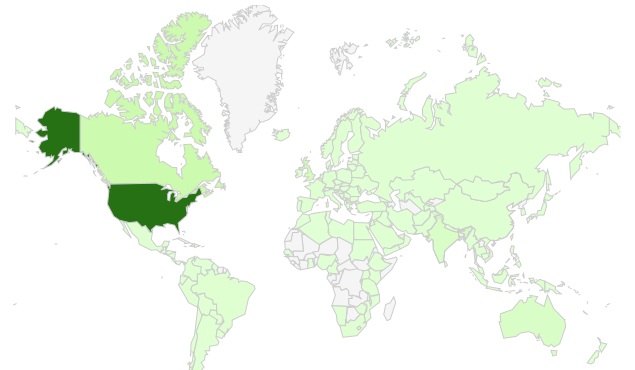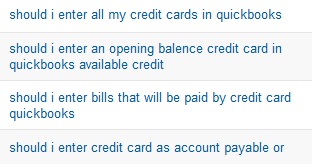28 May2012
Written by Dustin Wheeler, CPA. Posted in Humor, Social Media
While I’m not a power user of Google Analytics like those who track e-commerce and advertising performance, I know my way around it well enough to discover fun and interesting facts about my blog’s visitors. Below are a few insights into my blog’s statistics:
- I love maps! The Demographics-Location screen shows that my blog has nearly spanned the globe. It’s no surprise that the United States is the darkest shade of green, which means that it is the country with the most number of visits. The countries in grey have yet to make a visit. I am still waiting for Greenland to turn green. If you have friends there, send them my way.

- It is always interesting to see the search keywords used to get to my site. “Should I…” is a very common search phrase. Sure, I can explain how to enter credit card charges correctly into QuickBooks, but don’t expect too much more from me.

- Below is a graph showing the value of my investment portfolio. Just kidding! The graph shows the number of daily website visits. It is satisfying to see an increase in web traffic over time. This is a good lesson for people just starting to blog to not be discouraged by low numbers. Loyal readers, links from other sites, and search results accumulate over time, so don’t give up!

25 Oct2010
Written by Dustin Wheeler, CPA. Posted in Social Media
Last Saturday, I attended WordCamp Las Vegas. WordCamp is a conference that focuses on the popular blogging platform WordPress, which I used to create this blog. Most of those who attended were full-time web designers and programmers. I was probably most likely definitely the only accountant there.
I admit that some of the material presented in the conference was a little over my head, especially when they got into PHP code. My PHP coding skills are a level or two above copy and paste.

John Lynn speaking at WordCamp.
- Passion and motivation are the keys to blogging, according to my friend and client John Lynn. If anyone has that passion and motivation, it’s him, having written about 6,000 blog posts in the past 5 years. This year, John quit his full-time job and earns enough advertising revenue from his blogs to support his family. John’s most recent entrepreneurial project is a website to help raise money for sports teams and non-profit organizations. You can see John’s PowerPoint presentation on his website to learn about how he became a full-time blogger. Check out the plug he gave me on slide 8 (thanks, John).
- WordCamp brings in a tech-savvy crowd. It seemed like everyone had a laptop, iPad and iPhone. It was a good thing I bought a Droid X last month because it helped me to blend in a little bit.
- Creating a good podcast is a lot more difficult than having a microphone and recording an MP3 file. Scott Whitney from Podworx gave an entertaining and enlightening presentation showing how they incorporate music and eliminate the uh’s and um’s when recording podcasts.
- The M&M peanut butter brownies at the Palace Station buffet were pretty tasty!
- I didn’t take any notes on paper. I used Twitter to jot down great quotes and to have a record of stuff I want to look into later. On top of that, I shared those tweets using the hashtag #wclv with the rest of the attendees, and one of them expressed her appreciation for it!
- Twitter provided me with opportunities to meet people in person that I had read tweets from during the conference (i.e. “hey, you’re @techguy”)! Did I mention I need to change my cryptic Twitter name? Nobody came to me and said, “hey @whe97007!”
- For security reasons, don’t use the default username “admin” to log into your WordPress admin page. FYI hackers, my new username is “Dustin.”
- I need to try out WordPress’ photo editor instead of using Photoshop every time to touch up photos. It can do more than I previously thought.
- WordPress is a very powerful blogging platform and the possibilities of what you can do with it are almost endless. A couple of the conference sessions were mind-boggling.
- I’m planning to come back again next year.
05 Aug2010
Written by Dustin Wheeler, CPA. Posted in Social Media
Many villains in TV shows and movies have evil plans to take over the world. I have a much more attainable goal: take over the first page of Google when my name is searched for! *insert maniacal laughter here*

I thought it would be a good idea to “take over” Google when I read this blog post in the Harvard Business Review: Forget the business card – just Google me. I love the business card in that blog post (which just shows a Google search box with the person’s name).
A side benefit of this blog – although I didn’t create it solely for this purpose – is people being able to find me through my blog when searching for me on the Internet. I recently Googled my name and found my blog in the first position among the search results (see below). I used a few simple search engine optomization strategies to accomplish this. My domain name includes my first and last name, my name is in the title tag of the blog, and the “about me” page is written in third person (even though it would have been more natural to write it in first person).

Another strategy I recently began to implement is commenting on other people’s blogs. The main reason why I comment on blogs is to add value to them, but search engine optimization is a side benefit. The Google indexing robot finds my name and a link to my blog in each comment.
Now that I have a presence for my name in Google searches, I can finally think about getting one of those fancy Google business cards … and ponder another devious plan.
06 May2010
Written by Dustin Wheeler, CPA. Posted in Social Media, Tech Tips
First, let me describe my background in regards to web design so you know where I’m coming from.
I built my first web page in the year 2000 using Yahoo Geocities’ WYSIWYG site builder. It was simple. I just typed out some text and dragged it where I wanted it, and put pictures where I wanted them on the page. It was fun and sparked an interest to learn more about web design.
Shortly after that, I took a web page design class in college. The course almost entirely focused on html code. I enjoyed the course and felt proud to finally be a sophisticated “hard coder” creating web pages with Notepad. I created several websites by just writing html code and CSS, including the website for my company, a Las Vegas CPA Firm.
However, I soon discovered that creating a website this way has its problems. For example, changing a navigation bar for all pages in the website required me to cut and paste new code to all of the twenty-or-so html documents that comprised each page of the website.
My eyes were opened to a better way of managing a website at the AICPA Technology Conference in June 2009. One of the speakers demonstrated how he used a content management system (CMS) to pull content from other sources on the Internet and automatically create html code. Another session of the conference was entirely about “blogging, podcasting, and social networking” which covered how a blog can benefit a professional. I left the conference with the resolve that I wanted to learn to use a CMS and become a blogger!
It was a long journey from June to November 2009, when I posted my first article on my blog. Why did it take so long? Consider that I did all of the following:
- I carefully observed several other CPA bloggers and picked out things I liked and didn’t like from their blogs.
- I researched several CMSs and blogging platforms, including Joomla, Drupal, Blogger, and WordPress. I finally settled on using self-hosted WordPress so I could have total control over my blog and customize it as much as I like.
- I purchased my domain and web hosting after a few hours of researching several web hosting services.
- I installed WordPress on my web server.
- Among more than one thousand themes (or general designs) on the wordpress.org website, I had to choose my favorite. I then had to further customize my design so my blog wouldn’t look exactly like other blogs using the same theme.
- I installed several plugins and widgets (programs for backup, security, and sections of my blog, such as the Twitter and Google Reader feeds on the right sidebar).
- I started an account with Feedburner to create an RSS feed.
- I opened an account with Google Analytics and configured it to work with my blog, which I have discovered to be a great resource to see statistics of the traffic to my site.
- I also opened an account with Google Webmaster Tools to observe how Google indexes my blog.
- I created an “about me” page and a disclaimer (every blog should have one!)
- At this point, I started writing blog posts. Every blog post has to catch the reader’s attention, be informative, and be entertaining. I wouldn’t write anything I wouldn’t want to read myself! It’s not easy.
This might all sound overwhelming to someone who has never created a website. If you’re in this category, I have some good news. It doesn’t have to take months to start blogging. In fact, I created a simple blog using Blogger and finished it in about an hour. This blog (dustinwheelercpa.com) took me so long because I created it the hard way, and I’ve learned a lot in the process.





